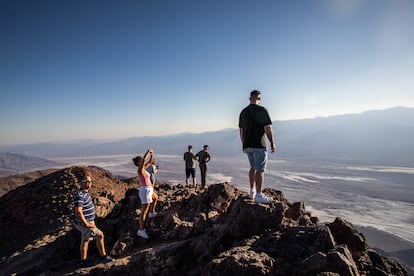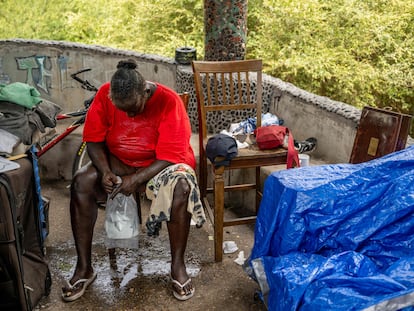Extreme heat tourism in Death Valley: ‘It’s too much, it’s just unbearable!’
The prospect of record-breaking heat in the California national park has drawn floods of European tourists exposing themselves to the dangers of a uniquely aggressive ecosystem


Heather can’t contain a smile as she mentions how many customers this summer’s record-breaking temperatures have brought her. “We sold twice as much as usual over the weekend,” says the manager of the souvenir store in Death Valley, the hottest place in the United States and the record-holder for the highest temperature ever recorded on the planet. Heather speaks with pride about the boom that the Furnace Creek community, on the border between California and Nevada, has witnessed due to the possibility of the 1913 record of 134º F (56.7º C) being beaten. “In the end it didn’t happen, but it was very exciting. We even had a little protest and everything!” she says.
The demonstration she refers to was held by a small group of environmental activists who came to shout “Happy Death Day!” at tourists taking selfies next to a large digital thermometer. The event provided some life in an area that generally lacks it. When the sun is in the sky, this huge nature reserve is a ghostly wasteland. Roadside signs warn of the extreme danger posed by the heat. On hiking trails, the message is even more direct. “HEAT KILLS,” reads a large banner that advises against walking outdoors after 10 a.m. “Come prepared to survive,” reads one of the National Park Service’s warnings.
We were curious about the extreme heat; we wanted to experience it once in our lives”Joaquín Rivera, American tourist
Joaquín and Rebeca Rivera were among the tourists who visited the area during the recent heatwave, attracted by the prospect of witnessing a world record. Originally from San Diego, they decided to modify their route to Las Vegas after reading in the press that the previous record was in danger. “We were curious about the extreme heat; we wanted to experience it once in our lives,” says 62-year-old Joaquín at the national park’s visitor center. Their documentation of the trip was eventually limited to taking pictures of the thermometer on the car’s dashboard, after they verified that it was too hot to go outdoors.
Still, there are those who are determined to try. The park rangers explain that in summer the number of U.S. visitors naturally decreases and the bulk of the tourists are European. On Tuesday, a group of 93 French people visited the park. Cirile and Juliette, two students originally from Grenoble, approached the Mesquite dunes, one of the park’s most famous sites. “It’s too much, it’s simply unbearable!” said Cirile. She elected to remain near the car, rather than approach the huge mountains of golden sand, a picture postcard of this desert landscape. Juliette, her face tomato-red under a cap, tried to provide an opinion, but the words wouldn’t come out: “I can’t speak English in this heat,” she said.

A fragile ecosystem, under threat
Death Valley officially recorded the highest temperature on the planet at Furnace Creek on July 10, 1913, when the thermometer supposedly reached 134º F (56.7º C). However, there are meteorologists and historians who dispute the veracity of this measurement, taken only two years after records began. The Weather Company, operated by IBM, claims that the highest recorded ambient temperature on Earth indeed in Furnace Creek, but in July 2021. For a couple of decades now, satellites equipped with NASA technology that allows high-resolution imaging have captured the Lut Desert in Iran and the Sonora Desert in Mexico reaching 80º C (176ºF) on their surfaces. These sites, however, have cold nights, while in Death Valley, it is 46ºC (114.8ºF) at 10 p.m.
Climate change, however, is making it increasingly likely that record temperatures will be reached or broken. In 2020, the temperature exceeded 37.7ºC (99.8ºF) in Death Valley for 169 days. In 2021, there were 11 days at above 51.6ºC (124.8ºF), according to the National Weather Service.
Rising temperatures threaten to end the valley’s already fragile ecosystem. The heat has caused an explosion in numbers of a beetle that is a pest to the area’s thousand-year-old pine trees, which have been barely surviving California’s chronic drought. Tree mortality has increased 70% over the last decade. The bird population has also declined.
[People come] with a false sense of security. They believe that having a cell phone and a vehicle is enough, but cars can break down and in most of the park there is no cell signal”Park Ranger Abby Snow
The valley has other attractive features for adventurers. A point known as the Badwater Basin is the lowest in North America at 282 feet (86 meters) below sea level. The region also has the driest land in the United States. On average, only five centimeters of rain falls per year, a phenomenon that is compounded by hot air that burns skin and accelerates the evaporation process in humans and animals. In the summer and with the wind blowing, a person can lose up to seven liters of water sitting in the shade, where the temperature does not drop below 46ºC (114.8ºF).
Park Ranger Abby Snow says that many visitors to Death Valley come with “a false sense of security. They believe that having a cell phone and a vehicle is enough, but cars can break down and in most of the park there is no cell signal.”
Reserve managers recommend at least four gallons (15 liters) of drinking water per person. According to National Park Service figures, there are between one and three heat-related deaths each summer. Last Tuesday, a 77-year-old man from Las Vegas collapsed outside a restroom in Golden Canyon, one of the park’s hiking trails. It is believed that his death was due to heat stroke when the thermometer reached 51ºC (123.8ºF). If confirmed, it will mark the second heat-related death of the season.

Death Valley can surprise even the most prepared visitor. On August 7, 2012, Michael Popov, an experienced ultramarathon runner, died while training for a 160-kilometer (100-mile) race. The 34-year-old Russian athlete set out at around 2 p.m. in temperatures above 50ºC (122ºF) with the intention of running cross-country for about 10 kilometers. Although he had completed races in the past that stretched to more than 60 hours, the desert was enough to defeat him in two and a half hours. He was found on a paved road, conscious, but delirious and aggressive. His heart stopped minutes later. Doctors determined that he had died of asphyxia due to a hemorrhage in his lungs caused by the heat. The ultramarathon community believes that his fatal mistake was to have run the course with two liters of water, when athletes need at least two to three liters per hour to avoid succumbing to heat.
Sign up for our weekly newsletter to get more English-language news coverage from EL PAÍS USA Edition
Tu suscripción se está usando en otro dispositivo
¿Quieres añadir otro usuario a tu suscripción?
Si continúas leyendo en este dispositivo, no se podrá leer en el otro.
FlechaTu suscripción se está usando en otro dispositivo y solo puedes acceder a EL PAÍS desde un dispositivo a la vez.
Si quieres compartir tu cuenta, cambia tu suscripción a la modalidad Premium, así podrás añadir otro usuario. Cada uno accederá con su propia cuenta de email, lo que os permitirá personalizar vuestra experiencia en EL PAÍS.
¿Tienes una suscripción de empresa? Accede aquí para contratar más cuentas.
En el caso de no saber quién está usando tu cuenta, te recomendamos cambiar tu contraseña aquí.
Si decides continuar compartiendo tu cuenta, este mensaje se mostrará en tu dispositivo y en el de la otra persona que está usando tu cuenta de forma indefinida, afectando a tu experiencia de lectura. Puedes consultar aquí los términos y condiciones de la suscripción digital.
More information
Archived In
Últimas noticias
Most viewed
- Alain Aspect, Nobel laureate in physics: ‘Einstein was so smart that he would have had to recognize quantum entanglement’
- David King, chemist: ‘There are scientists studying how to cool the planet; nobody should stop these experiments from happening’
- Mexico completes its trade shift with the entry into force of tariffs on China and countries without trade agreements
- Reinhard Genzel, Nobel laureate in physics: ‘One-minute videos will never give you the truth’
- Oona Chaplin: ‘I told James Cameron that I was living in a treehouse and starting a permaculture project with a friend’










































